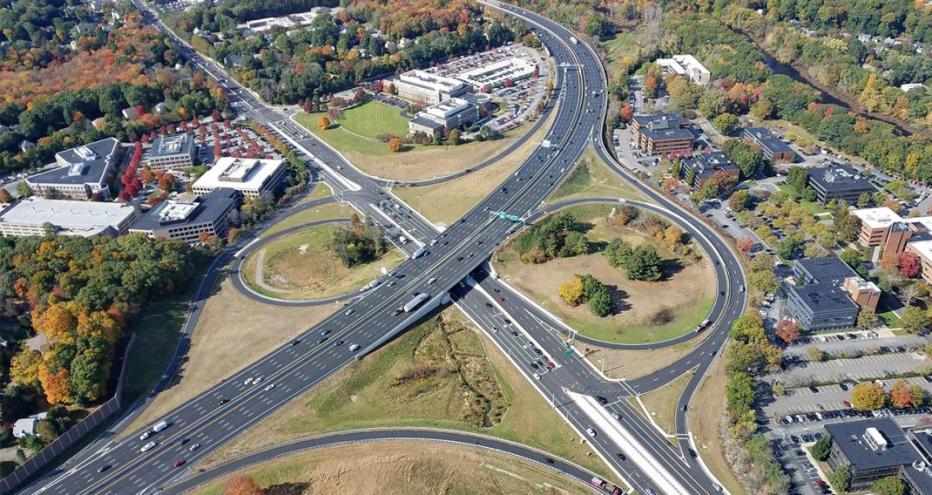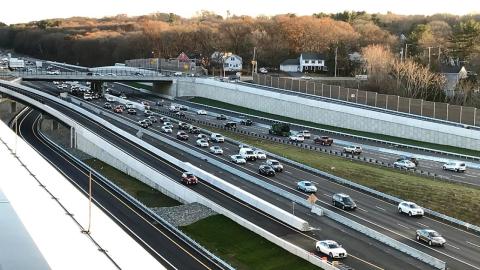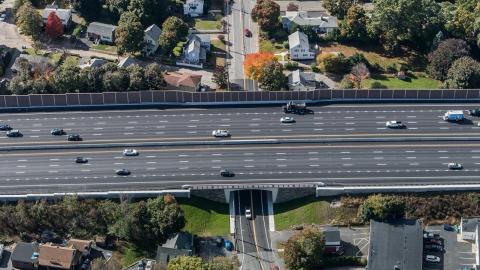
The $186 million I-95 – I-93 Transportation Improvement Project improves the quality of life of those who live and work along the corridor and the 300,000 users traveling on I-95 and through the three interchanges. The Jacobs/HDR team employed several unique and innovative approaches to solve complex transportation issues, avoid removing 40,000 cubic yards of soft organic soils (saving $4 million); provide significant noise abatement; improve access for all mobility users, improve water quality; and put over seven acres of riverfront land into permanent conservation.
This project was the last and most complex phase of a 20-year effort by the Massachusetts Department of Transportation to widen the I-95 corridor to four travel lanes and two full shoulders in each direction from Wellesley to Canton, Massachusetts. This final 3.5-mile segment in Wellesley and Needham included modifications to two interchanges, construction of a new interchange, two collector-distributor roads, two auxiliary lanes from Route 9 and Highland Avenue, and four bridges, and widening of a historic bridge.
A major contribution provided by the project is the opening of a new interchange at Kendrick Street. The new interchange, bridge, retaining walls, and traffic signals provide a dramatic access improvement, as well as economic opportunities to the neighboring communities. This interchange has become a catalyst to commercial development and is a factor driving an additional 2 million square feet of commercial and residential real estate in the surrounding towns.
-
10 K+
feet of retaining walls
-
2 M
square feet of economic redevelopment space
-
10 K
feet of noise barriers
-
40 K
cubic yards of peat saved from removal
“Employing several innovative approaches to deliver a project that improves the quality of life of those who live and work along the corridor made this project a great success. The benefits include a safer way to travel, additional roadway capacity, improved access for many types of modes, improved environmental quality and two million square feet of economic redevelopment space - a true success.”
A Look at the I-95 - I-93 Transportation Improvements Project
Preserving Historic Bridges
The existing bridges carrying I-95 over Central Avenue in Needham are single-span, concrete, rigid-frame structures, built in 1953. Two independent structures, which carried the northbound and southbound mainline roadways, were separated by an open median. Their concrete rigid frame structure is uncommon in Massachusetts. Their stone-faced abutments and median wall, and modestly ornamented steel railings are typical of the 1950s modern aesthetic. The Central Avenue bridges were found to be eligible for individual listing in the National Register of Historic Places and are now listed on the MassDOT Historic Bridges List. To accommodate the additional highway lanes and to protect the historic interests, the existing bridge structures were widened in the median and to the outsides, to create one unified bridge. For a consistent appearance, the new portions of the bridge are concrete, rigid frames with geometry matching the two existing structures. Existing granite fascia stones were reused on the new wingwalls and the ornamental steel railing was rebuilt on both sides of the new bridge.
Improving Pedestrian and Bicycle Accommodations
A major benefit of the project was the ability to incorporate complete streets along the local roadways that span over I-95. Ensuring that these roads provide safe mobility for all travelers with dedicated bike lanes, bike signalized intersections, and painted intersection crossings enabled safe use and supports an increase in mobility for all users. The team worked with the active biking community to ensure that the proposed improvements met their needs since Kendrick Street and Highland Avenue are the only roadways to cross I-95 in that area.
Environmental Considerations
Improving the natural and living environment within the project limits was a prime driving force of the client and design team. The improvements incorporated into the project included:
- Noise Abatement: Open graded friction course (OGFC) pavement was used, which reduces road noise. In addition, 10,000 feet of new noise barriers were constructed along 7 neighborhoods.
- Improved Water Quality: The number of individual drainage outfalls was significantly reduced and 20 new stormwater treatment facilities were constructed.
- Use of OGFC Pavement to Reduce Pollutant Run-off: In addition to the noise reduction benefits of OGFC pavement, it also helps to contain the pollutants in the drainage run-off from the pavement. MassDOT has commissioned a study by the USGS to confirm these benefits.
Timber Pile Supported Embankment
To construct the additional travel lanes, embankments were extended into the interior of the median area up to approximately 70 feet along the northbound travel lanes and up to approximately 100 feet along the southbound travel lanes. Several design and construction alternatives were evaluated for support of the embankment:
- Preload/surcharge loading to allow organic/peat consolidation to occur prior to embankment and roadway construction.
- Ground improvement extending through the compressible fill and organic soils to create a stiffer composite soil matrix.
- Mechanically stabilized earth (MSE) retaining walls.
- Excavation of the fill and organic soils and replacement with structural fill.
- Embankment support using over 2,600 timber piles that extend through the compressible fill, and organic soils to derive support from the natural granular soils. A working platform constructed with geogrid on top of the piles.
Ultimately, the timber pile alternative was chosen and constructed. It was the first such use by MassDOT.














































